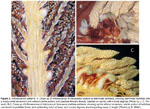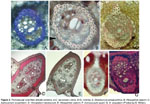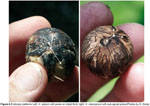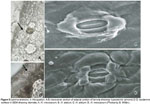Servicios Personalizados
Revista
Articulo
Indicadores
-
 Citado por SciELO
Citado por SciELO
Links relacionados
-
 Similares en
SciELO
Similares en
SciELO  uBio
uBio
Compartir
Revista Peruana de Biología
versión On-line ISSN 1727-9933
Rev. peru biol. v.15 supl.1 Lima nov. 2008
TRABAJOS ORIGINALES
The genus Hexopetion Burret (Arecaceae)
El género Hexopetion Burret (Arecaceae)
Jean-Christophe Pintaud1 ; Betty Millán2 y Francis Kahn3
1 IRD, UMR DIA-PC/DYNADIV, Laboratoire Genetrop, 911 Avenue Agropolis, BP 64501, 34394 Montpellier Cedex 5, France. Email: jean-christophe.pintaud@ird.fr
2 Museo de Historia Natural, Universidad Nacional Mayor de San Marcos, Lima – Perú. Avda. Arenales 1256 Jesús María, Lima 14, Perú.
3 IRD, UMR188-DIAPC, DYNADIV, Casilla 18-1209, Lima, Perú.
Trabajo presentado al Simposio Internacional Las palmeras en el marco de la investigación para el desarrollo en América del Sur, del 07 al 09 de Noviembre 2007, Museo de Historia Natural, Universidad Nacional Mayor de San Marcos, Lima, Perú.
Abstract
The genus Hexopetion was described by Burret to accommodate a single species, H. mexicanum. We reinstate the genus on the basis of morphological and anatomical data, and enlarge it to include a second species, Astrocaryum alatum, for which a new combination is made.
Keywords: Arecaceae, Hexopetion, new combination, reinstated genus.
Resumen
El género Hexopetion definido por Burret con una única especie, H. mexicanum, se restablece a partir de datos morfológicos y anatómicos. Se incluye una segunda especie, Astrocaryum alatum, para la cual se hace una nueva combinación.
Palabras clave: Arecaceae, Hexopetion, nueva combinación, género restablecido.
Introduction
Burret (1934a) revised the genus Astrocaryum. He divided his section Ayri in two subsections: (i) Hexodon including a single species, Astrocaryum mexicanum Liebm. ex Mart., caracterized by the presence of 6 distinct, tooth-like staminodes in the pistillate flower (Flos FEM: Corolla intus staminodiis dentiformibus inter se disjunctis), and (ii) Symphyodon including several species having the pistillate flower with a complete staminodial ring.
Later the same year, Burret (1934b) considered this species to worthy of a generic rather than subsectional rank and created the genus Hexopetion with H. mexicanum as type and only species. This change in Burrets point of view within such a short time clearly points to the difficulty he faced in classifying this species. Apart from the staminodial structure mentioned in the first article, Hexopetion was also defined by the pistillate flower inserted at the base of the rachilla with contiguous staminate flowers that entirely and densely covered the rachilla i.e. there is no sterile part on the rachilla between the pistillate flower and the basal staminate flowers (Rami basi ima flore FEM quam MASC majore, dein ininterrupte sequentibus MASC densis obtecti).
A new species from Central America, Astrocaryum alatum, was described shortly after by Loomis (1939). Loomis compared A. alatum with A. standleyanum, not with Hexopetion mexicanum because this species had been removed from Astrocaryum. Loomis did not realize that the new palm he was describing shared several characters with H. mexicanum, making both species different from all other species of Astrocaryum. De Nevers et al. (1988) and Henderson et al. (1995) did recognize the close affinity between A. mexicanum and A. alatum but considered both species in Astrocaryum, as did Glassman (1972) and Uhl and Dransfield (1987) before them. Hexopetion and Astrocaryum are superficially similar in sharing the white indument on abaxial surface of pinnae, flattened spines, robust inflorescence branched to one order with catkin-like staminate rachillae or distal portion of them, pistillate flower(s) basal and considerably larger than staminate ones, fruits large, oval-obovoid, rostrate, spiny, endocarp with superficial black fibers forming a star-like pattern around germinating pores.
Further investigations of morphological and anatomical characters made by us however corroborated the clear divergence of A. mexicanum and A. alatum from the rest of the genus Astrocaryum. This leads us to reconsider Hexopetion as a distinct genus and to enlarge it to include A. alatum, for which a new combination is made here.
Data supporting the reinstatement of
Hexopetion Burret
Hexopetion differs from Astrocaryum in:
1. Morphological data
Multifold lateral segments in adult palms (Fig. 1). This is found in Astrocaryum only in juveniles when the bifid eophylls start to split, later in development, the segments are always single-fold, either regularly arranged or grouped (Fig. 1).
Staminate flowers covering the whole rachilla, without sterile part (Fig. 2).
Rachilla woolly-white between the flowers (Fig. 2).
Stigmas much shorter than ovary (Fig. 2).
Additionally, it is to be noted that despite the considerable diversity of life forms exhibited by Astrocaryum (Kahn, 2008), no species of that genus matches the habit of Hexopetion species. Apart from the irregular division of leaves in Hexopetion, the medium-sized slender, bare trunk that characterizes H. mexicanum exists only in the caespitose A. gynacanthum and A. huaimi and the single-stemmed A. minus and A. echinatum.
2. Leaf anatomical data
Perivascular sclerified sheath continuous (discontinuous in Astrocaryum). Within Bactridinae, only Astrocaryum has a discontinuous perivascular sheath, interrupted by parenchymatous tissues (Fig. 3).
Hexopetion Burret
Burret (1934b:156)
Astrocaryum Subsectio Hexodon Burret (1934a:153).
Type species: Hexopetion mexicanum (Liebm. ex Mart.) Burret
Description of the genus:
Solitary, short to medium-sized, spiny, pleionanthic, monoecious tree palms. Stem erect, covered either with rows or groups of black flat spines or with remains of leaf bases. Leaves pinnate, caducous or marcescent, sheath, petiole and rachis spiny and covered with an appressed hairy-scaly indument, blade irregularly divided in multifold or single and multifold segments intermixed, with a white indument abaxially, plication reduplicate. Inflorescences interfoliar, erect to ascending, branched to one order, prophyll short, bicarinate, fibrous, hidden in leaf bases, peduncular bract prominent, rostrate, densely spiny adaxially, glabrous abaxially, peduncle densely spiny, rachis shorter than peduncle, not spiny, rachis and rachillae covered with a dense wooly-white tomentum, rachillae entirely covered by staminate flowers, these shallowly sunken in pits, pistillate flowers directly inserted at the base of rachilla or directly on main rachis in between staminate rachillae and without evident connection with them. Staminate flowers symmetrical, trimerous, not widely open at anthesis, sepals 3 short, imbricate, free, petals 3, valvate, stamens 6, slightly exceeding petals at anthesis, anthers small, dorsifixed, oval-linear with sagittate base, pistillode reduced. Pistillate flowers subtended by a membranous bract, calyx shorter than or equaling corolla, cup-shaped or globose-inflated, truncate, tridenticulate, corolla tomentose-spiny, limb straight, staminodes either free, tooth-like or connate in a ring, pistil tomentose or tomentose-setose, tricarpelate, uniovulate, stigmas small, trifid, lobes tiny, straight to spreading or recurved. Fruit ellipsoid to obovoid or subglobose, shortly rostrate, epicarp sparsely to densely spiny, mesocarp fleshy-fibrous, endocarp bony, externally with appressed blackish, anastomizing fibers forming a star-like pattern around germinating pores, these located in distal third or sub-apical, endosperm homogeneous. Eophyll bifid.
Etymology: from greek, hexo=six; and from latin, petere=towards the center. Burret probably referred to the six tooth-like staminodes inside the corolla.
1. Hexopetion mexicanum (Liebm. ex Mart.) Burret
Burret (1934b:156); Dahlgren (1959, pl. 302-305).
Astrocaryum mexicanum Liebm. ex Mart., Liebman (1846:8, 10 nomen) descr. in Martius (1853:323); Mueller (1858); Burret (1929:837; 1933:98; 1934a:153); Standley and Steyermark (1958: fig. 37); Glassman (1972:18); Henderson et al. (1995:205); Govaerts and Dransfield (2005:14)
Astrocaryum rostratum Hook. f. Hooker (1854: tab. 4773; 1857: tab. 138); Mueller (1858); Burret (1933:98)
Astrocaryum warscewiczii Kart. Karsten (1858:297).
Bactris cohune S. Wats. Watson (1886:467).
Astrocaryum cohune (S. Wats.) Standl. Standley (1930:25).
Astrocaryum chichon Linden, nomen Linden (1881:15)
Astrocaryum ayri Hortorum ex Warburg, not Martius Warburg (1922:409, fig. 220B); Burret (1933:98).
2. Hexopetion alatum (Loomis) F. Kahn et J.C. Pintaud, comb. nov.
Astrocaryum alatum Loomis (1939:142, figs 1-2); Moore and Chazdon (1985:82); De Nevers et al. (1988:94); Henderson et al. (1995:203).
Taxonomical notes
Three characters mentioned by Burret as distinct in Hexopetion and Astrocaryum are not so with the inclusion of A. alatum in Hexopetion: (i) staminode structure H. mexicanum has distinct tooth-like staminodes while H. alatum has a staminodial ring; similar variation is observed within Astrocaryum (Kahn and Millán, 1992) and within Bactris (Henderson, 2000); (ii) position of pores on endocarp subapical in H. mexicanum, in the distal third in H. alatum (Fig. 4); and (iii) position of embryo correspondingly variable. Tabla 1. Leaf anatomical characters compared in H. alatum and H. mexicanum.
Henderson et al. (1995) suggested that the two species are doubtfully distinct. They appear in fact to be amply distinct in many vegetative and reproductive characters (see key below) and also in leaf lamina anatomy (Table 1 and Fig. 5). Relationships of Hexopetion within Bactridinae are still unclear and await a detailed phylogenetic study in progress (Borchsenius et al., in prep.). Tabla 1. Leaf anatomical characters compared in H. alatum and H. mexicanum.

Distribution
Throughout Central America, from southern Mexico to Panama, mostly on the Atlantic side except Yucatan peninsula. There is a gap in Nicaragua between the northern distribution of H. mexicanum and the southern one of H. alatum.
Ecology
Palms of the understorey of lowland rainforests. Hexopetion mexicanum (as Astrocaryum mexicanum) has been a model species in tropical forest population ecology (Piñero et al., 1977, 1982, 1984, 1986; Piñero and Sarukhan, 1982; Burquez et al., 1987; Mendoza et al., 1987; Martinez-Ramos et al., 1988; Eguiarte et al., 1992, 1993).
Key to species:
-Trunk 1017 cm diam., covered with persistent spiny leaf bases; staminate flowers 610 mm long; pistillate flower directly inserted on the rachis, calyx globose-inflated, equaling corolla, staminodes forming a ring; fruit obovoid to subglobose with sparse black spinules, endocarp with pores in the distal third Hexopetion alatum
-Trunk 2,58 cm diam., without persistent leaf bases and with rings or groups of flat black spines; staminate flowers 5 mm long; pistillate flower inserted at the base of the rachilla, calyx cup-shaped, shorter than corolla, staminodes distinct, tooth-like; fruit ellipsoid to obovoid densely covered with short, black spinules, endocarp with sub-apical pores Hexopetion mexicanum
Acknowledgements
We are especially grateful to Scott Zona (Fairchild Tropical Botanical Garden, Miami) for providing access to most of the studied material and for taking photographs. We are grateful to Nancy Rojas (Facultad de Medicina, Universidad Nacional Mayor de San Marcos, Lima, Perú) for the preparation of specimens for SEM.
Literature cited
Burquez A., J. Sarukhan & A.L. Pedroza.1987. Floral Biology of a primary rainforest palm Astrocaryum mexicanum Liebm. Bot. J. Linn.Soc., 94: 407–419.
Burret M. 1929. Die Heimat von Astrocaryum rostratum Hook f. Notizblatt Bot. Gart. Mus. Berlin-Dahlem, 10: 837–838.
Burret M. 1933. Bactris cohune S. Watson=Astrocaryum mexicanum Liedm. Fedde Rep. Spec. Nov. Regni Veg., 32: 98–99.
Burret M. 1934a. Die Palmengattung Astrocaryum G.F.W. Meyer. Repert. Spec. Nov. Regni Veg., 35: 114–158.
Burret M. 1934b. Palmae neogeae. Notizblatt Bot. Gart. Mus. Berlin-Dahlem, 12: 151–159.
Dahlgren B.E. 1959. Index of American palms. Plates. Field Mus. Nat. Hist. Bot., 14: pls 1–412.
De Nevers G.C., M.H. Grayum & B.E. Hammel. 1988. Astrocaryum confertum, an enigmatic Costa Rican palm rediscovered. Principes 32: 91–94.
Eguiarte L.E., N. Perez-Nasser & D. Piñero. 1992. Genetic structure, outcrossing rate and heterosis in Astrocaryum mexicanum (tropical palm): implications for evolution and conservation. Heredity, 69: 217–228.
Eguiarte L.E., A. Burquez, J. Rodriguez, M. Martinez-Ramos, J. Sarukhan & D. Piñero. 1993. Direct and indirect estimates of neighborhood and effective population size in a tropical palm, Astrocaryum mexicanum. Evolution, 47 (1): 75–87.
Glassman S. 1972. A revision of B.E. Dahlgrens Index of American Palms. Verlag von J. Cramer, Lehre.
Govaerts R. & J. Dransfield. 2005. World checklist of palms. Royal Botanic Gardens, Kew.
Henderson A. 2000. Bactris (Palmae). Flora Neotropica Monograph 79, The New York Botanical Garden, New York.
Henderson A., G. Galeano, G. & R. Bernal. 1995. Field guide to the palms of the Americas. Princeton University Press, New Jersey.
Hooker J.D. 1854. (Astrocaryum rostratum). Curtiss Bot. Mag., 80 : tab. 4773.
Hooker J.D. 1857. (Astrocaryum rostratum). Illustr. Hort., IV, tab. 138.
Kahn F. 2008. The genus Astrocaryum (Arecaceae). Rev. per. biol. 15 (suppl. 1): 31-48.
Kahn F. & B. Millán, 1992. Astrocaryum (Palmae) in Amazonia: a preliminary treatment. Bull. Inst. fr. Ét. and., 21: 459–531.
Karsten H. 1858. (Astrocaryum warscewiczii). In Koch and Fintelm. Wochenschrift für Gärtnerei und Pflanzenkunde, I: 297.
Liebman F.M. 1846. Central Americas Palmenformer. Overs. K. Dansk. Selsk. Forhandl. pp. 4-10, Copenhagen.
Linden J. 1881. Plantes introduites et mises pour la première fois dans le commerce. LIllustr. Hort., 28 : 15–16.
Loomis H.F. 1939. A new palm from Costa Rica, Astrocaryum alatum. Jour. Wash. Acad. Sci., 29 (4): 141–146.
Martinez-Ramos M., J. Sarukhan & D. Piñero. 1988. The demography of tropical trees in the context of forest gap dynamics: The case of Astrocaryum mexicanum Los Tuxtlas tropical rainforest. In: Davy, A.J., M.J. Hutchings & A.R. Watkinson (Eds.). Plant Population Ecology Blackwell, Oxford, pp. 293–313.
Martius C.F.P. von, 1853. Hist. Nat. Palm., 3: 315–350.
Mendoza A., D. Piñero & J. Sarukhan. 1987. Effects of experimental defoliation on growth, reproduction and survival of Astrocaryum mexicanum. J. Ecol., 75: 545–554.
Moore Jr. H.E. & R.L. Chazdon. 1985. Key to the palms of Finca La Selva, Costa Rica. Principes, 29 (2): 82–84.
Mueller C. 1858. Walpers annales Botanices Systematicae, 5: 804–857, Leipzig.
Piñero D., J. Sarukhan & E. Gonzalez. 1977. Estudios demográficos en plantas de Astrocaryum mexicanum. Bol. Soc. Bot. Mex., 37: 69–118.
Piñero D. & J. Sarukahn. 1982. Reproductive behavior and its individual variability in a tropical palm Astrocaryum mexicanum. J. Ecol., 70: 461–472.
Piñero D., J. Sarukhan & P. Alberdi. 1982. The costs of reproduction in a tropical palm, Astrocaryum mexicanum. J. Ecol., 70: 473–481.
Piñero D., M. Martinez-Ramos & J. Sarukhan. 1984. A population model of Astrocaryum mexicanum and a sensitivity analysis of its finite rate of increase. J. Ecol. 72: 977–991.
Piñero D., M. Martinez-Ramos, A. Mendoza, E., Alvarez-Buylla & J. Sarukhan. 1986. Demographic studies in Astrocaryum mexicanum and their use in understanding community dynamics. Principes, 30 (3): 108–116.
Standley P.C. 1930. A second list of the trees of Honduras. Trop. Woods 21: 25.
Standley P.C. & A. Steyermark. 1958. Palmae, in Flora of Guatemala I. Fieldiana Bot., 24: 196–299.
Uhl N.W. & J. Dransfield. 1987. Genera Palmarum; a classification of palms based on the work of H.E. Moore Jr. L.H. Bailey Hortorium and International Palm Society, Allen Press, Lawrence, Kansas.
Warburg O. 1922. Die Planzenwelt, 3: 409 (fig. 220B).
Watson S. 1886. Notes upon some palms of Guatemala. Contributions to American Botany, 13. Proc. Amer. Acad., 21: 464–468.



















